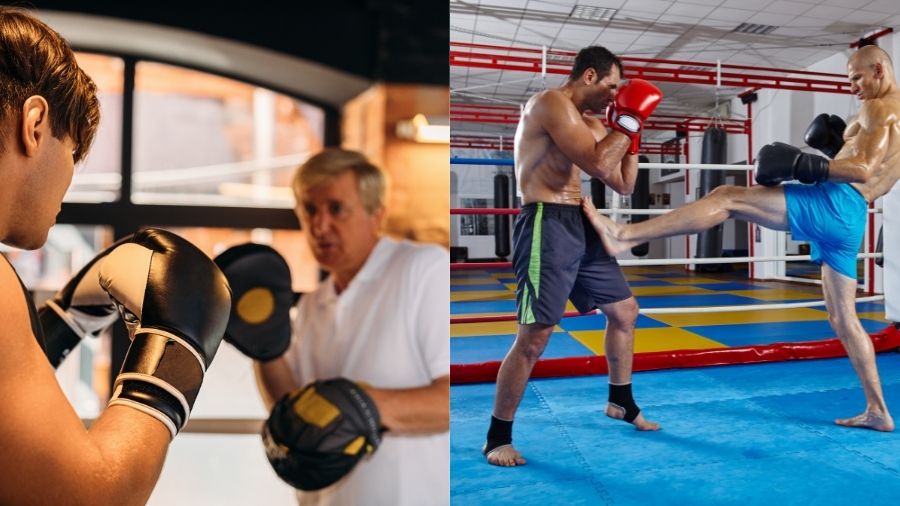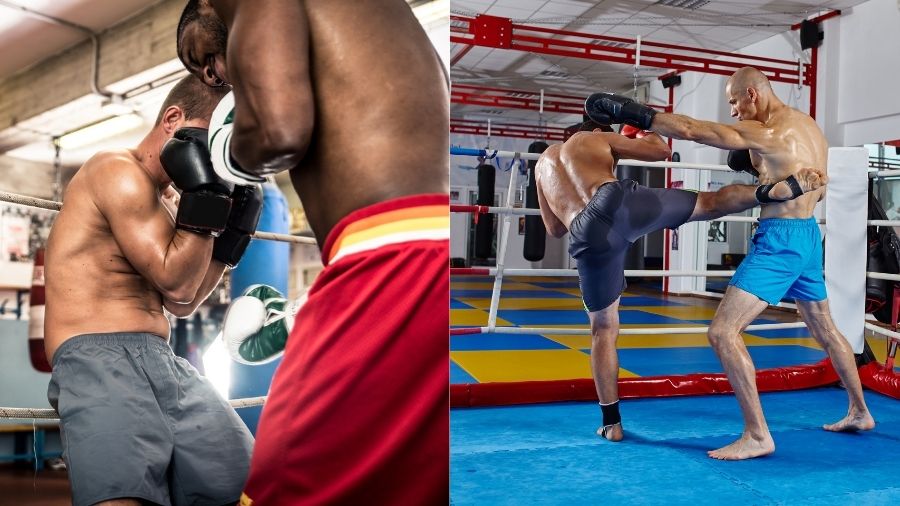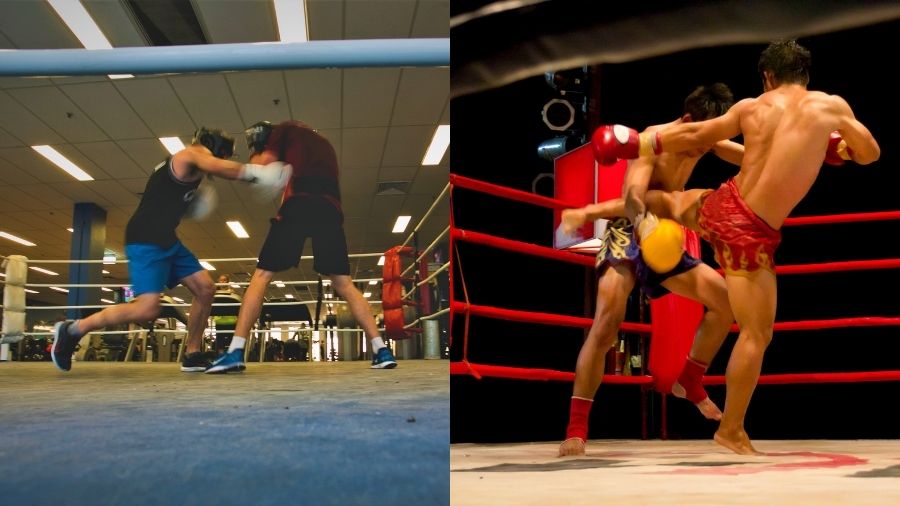While boxing has been the primary combat sport in the Western world for the last two centuries, Muay Thai quickly rose to prominence when people discovered its practicality and effectiveness for mixed martial arts. Both are strong striking styles, but which one would win in a fight?
In most cases, a Muay Thai fighter has a higher chance of winning against a boxer in a fight. The variety of attacks in the art of 8 limbs is often too much for a boxer to handle, but the result is decided based on the individual qualities of the fighters.
The comparison between Muay Thai and boxing should go much deeper than a mere one-on-one fight, so we will dissect all the advantages and shortcomings of both, helping you differentiate them better.
What Is Boxing?
Boxing is a combat sport that aims to knock out the opponent using only fists in a match contested in multiple timed rounds. If no one succeeds, the result is decided by judges based on a few different criteria.
We know competitive fist-fighting has been a part of human society since 3000 BC. In antiquity, boxing has been an essential part of the ancient Olympics from 776 BC to 393 AD.
Discover The Little Known Secrets For Unlocking Devastating KO Power!
Heavy hands are built doing these things...
However, the modern incarnation of the sport started to evolve in England during the 17th century, and the tradition of gentlemanly fist fighting continues to this day.
The sport has wonderful traditions and has long been an essential element in Western culture. Many elite boxers transcend the sporting world and become influential celebrities.
The limited number of legal techniques in boxing makes it harder for fighters to penetrate their opponent’s defenses.
This creates the need to employ complex footwork and other tactics to find and create openings. This emphasis on subtle techniques and tactics gave the name “the sweet science” to boxing.
What Is Muay Thai?
Muay Thai is a striking martial art and the national sport of Thailand. Muay Thai is called the “art of 8 limbs” because it allows striking with eight body parts- punches, kicks, elbows, and knees (two on each side).
The roots of Muay Thai can be traced back to 13th century Thailand. Its early forms were used for warfare, much like any old martial art.
Over time, the fighting styles evolved into Muay Boran, which can still be seen today, albeit only in demonstrations, and the sports version of Muay Thai.
The current version of the sport was formalized in the 1920s by adopting many aspects of Western boxing, like timed rounds, the boxing ring, and padded gloves.
On top of the rich striking arsenal, clinch fighting, sweeps, and throws are also permitted and rewarded. This makes Thai boxing the most diverse striking style, which has made it the preferred striking discipline for many MMA fighters.
Key Differences Between Boxing and Muay Thai

Rules
Muay Thai has a lot in common with boxing regarding the rules. Both sports are contested in a square ring in 3-minute rounds with 1-minute rest. Muay Thai matches are five rounds long, while boxing fights range from 3 rounds for amateurs to 12 rounds for professional title matches.
Knockouts and knockdowns are the most desired outcome in a fight. If both fighters are standing at the end of the allotted rounds, the fight will go to the judges’ scorecards.
In boxing, each round is scored separately on a 10-point must system. At the end of the fight, the individual scores are summed, and the fighter with more points is declared the winner.
In Muay Thai, each following round is more important than the previous. This often leads to the first two rounds being more of a feeling-out process, with the intense fighting starting in the 3rd.
In Muay Thai, kicks are scored better than punches, and sweeps and throws are highly appreciated. Because of this, the accent on punches is greatly overshadowed by kicks.
Equipment
The main difference in the equipment used in both sports is that boxers wear shoes while Muay Thai fighters are barefoot.
The boxing gloves used in both styles are almost the same, with some subtle differences. Muay Thai gloves allow better control in the clinch and when catching kicks, while boxing gloves are more heavily padded on the knuckles and have better wrist protection.
A lot more protective equipment is required for the training room. Both boxers and Muay Thai fighters use mouthguards and often wear headgear to protect themselves from cuts. For Muay Thai, you will also need shin guards and possibly kneepads, elbow pads, and ankle supports.
Techniques
An indisputable fact is that boxers are the best punchers in the world. Other sports like Muay Thai use the same set of punches- straights, hooks, and uppercuts, but are light years away from the proficiency of boxers.
The extensive use of kicks in Muay Thai means many subtle punching nuances are lost, and the hands often serve more as a setup than the main attack. Like boxers are famous for their powerful punches, Thai fighters excel at devastating roundhouse kicks.
Muay Thai kicks are not as diverse as the ones used in karate or taekwondo but are by far the most powerful. Therefore, the Thai-style roundhouse kick has been recognized and adopted as the “default” style used by most kickboxers and MMA fighters.
The other staple attacks of Muay Thai are elbows and knees. The elbow is one of the hardest bones in the body, capable of causing heavy concussions and cuts, and is expertly used by nak muay.
Another aspect distinguishing Muay Thai from other striking arts is the clinch. As the judges handsomely reward throws and sweeps, fighters use them extensively.
In boxing, the referee quickly separates clinches, and there are strict rules about what is allowed at the closest range.
Footwork
One of the most telling differences between Muay Thai and boxing is the stance and footwork.
The boxing stance can vary, but it’s usually bladed to give the opponent a smaller target, allow quick movements, and set the rear hand for powerful shots. The traditional boxing stance also is lead-foot-heavy.
On the contrary, Muay Thai fighters mainly use a square stance and keep their weight on the back foot to quickly throw a teep or check an incoming kick.
Boxing’s footwork is elaborate and very complex. At the same time, in Muay Thai, fighters are generally flat-footed. They move less and prefer to stand their ground, block, and fire back vicious counters immediately.
Extensive head movement typical for boxing becomes dangerous when knees and kicks are involved and can be rarely seen in Muay Thai.
This does not mean there aren’t some high-level technicians in Muay Thai, like Saenchai and Lerdsila, that produce mesmerizing matrix-like sequences. Still, the general strategy in Muay Thai relies more on power and toughness than on finesse and precision.
Fight Rhythm
The most significant factors that determine the different fight rhythms of boxing and Muay Thai are the number of weapons, duration of the fight, and scoring criteria.
Muay Thai is a sport steeped in tradition, and for multiple reasons, fights almost always start slowly and gradually build up the tempo.
Matches are 5 rounds long, but rounds 3 and 4 are the most important to win, and Thai fighters always expend the most energy in them.
In comparison, pro boxing fights are much longer and span from 8 to 12 rounds, which means they also tend to start with a slow feeling-out process.
But some boxers prefer to step on the gas early, and there is no set dynamic like in Muay Thai. Each match has an individual tempo, depending on the fighters.
Another critical factor in fight rhythm is the strike choice. Muay Thai fighters usually rely on single powerful strikes and use limited footwork.
Boxers do the opposite and like to throw punches in fluid combinations, maximizing the chance of landing. Footwork is also crucial in boxing, both offensively and defensively.
Safety
Any sport where the inherent goal is to hurt the opponent is bound to be very dangerous. The dangers of boxing and Muay Thai slightly differ, just like their rules and objectives.
The biggest safety concern in boxing has always been brain trauma since the head is the main target.
CTE is a serious issue for boxers because brain trauma becomes irreversible at a certain point, and it can impact daily life dramatically.
Not every pro boxer suffers from this problem, let alone regular practitioners, but brain damage is a topic every boxing enthusiast should research and be aware of the risks.
Muay Thai presents a real danger for brain damage, but because the whole body is open to attacks and the specific scoring, the head receives less punishment than in boxing.
But as a tradeoff, you need to worry about many more orthopedic injuries, like fractures, ligament damage, and countless bumps and bruises to the entire body.
Both boxing and Muay Thai are dangerous sports, and every practitioner needs to understand the risks. But they can also be practiced and enjoyed relatively safely when practitioners approach them correctly.
Competitive Landscape
Boxing has been around for nearly 2 centuries and is the most popular combat sport. As such, the completive landscape is well developed at all possible levels. There are two main types- amateur boxing and professional boxing.
Amateur boxing competitions span all skill levels, starting from kid tournaments and reaching the highest level possible at the Olympic games.
Many countries have government-backed boxing programs, national teams, and school programs.
As professional athletes, boxers enjoy significant earnings, and the sport is a part of pop culture, with many champions transcending boxing and becoming celebrities.
Muay Thai is significantly less popular than boxing outside of Thailand, where it’s a national sport and is at its best. Amateur Muay Thai competitions exist in many countries, but the level and participation is low.
As a professional sport, Muay Thai is popular not only in Thailand but in Asia in general, and organizations like One FC frequently hold high-level professional events.
In the West, Muay Thai is relatively popular, with many people training but fewer competitions available.
Strength & Conditioning
There’s a reason both boxing and Muay Thai structure their non-boxing conditioning work around high volumes of roadwork. High-level boxers and Muay Thai athletes have high VO2max values (an indicator of aerobic fitness), and both arts are highly aerobic.
Boxing conditioning should focus on lower intensity with aerobic training and the high end with alactic power intervals.
Hard sprint interval efforts are required to improve the muscles’ ability to resist fatigue. Conditioning for Muay Thai should follow a similar conditioning structure to boxing.
The structure of strength training is similar between boxing and Muay Thai. Both arts require immense speed and power for striking, with most of the strength coming from the legs. Strength training for boxing is traditionally shunned.
But as people become more educated and move away from traditional bodybuilding and powerlifting routines, they see considerable gains in punching power.
Muay Thai strength training has a similar approach to boxing, where the focus is on speed and power of the lower body. However, the addition of the clinch makes upper body isometric strength a vital aspect of strength training.
Boxing vs. Muay Thai For Self Defense

Both boxing and Muay Thai will arm you with a great set of skills for self-defense. In all full-contact combat sports, even training without competing will condition your body and mind for violent confrontations, at least to a degree.
But based on versatility, Muay Thai wins as a self-defense tool. Kicking is an excellent way to keep a safer distance, and this is something Muay Thai is very good at.
The punching in boxing is much better in general, but for a street fight, Muay Thai level punching is more than enough for almost every possible situation.
Even more critical for self-defense may be the clinch skills learned in Muay Thai.
Too often, street fights end up in close range, and with even modest knowledge and awareness, you can dominate an opponent who has no idea what to do.
The fast movement and powerful punches of boxing, on the other hand, maybe more useful in some situations.
There is no quicker way to dismantle an opponent than blasting him with a fast 2 or 3-punch combination and then removing yourself from danger.
Keeping your distance and kicking the attackers’ legs and body may be too slow a tactic for the frantic chaos of real-life combat.
Boxing vs. Muay Thai For MMA

In terms of effectiveness and transferability to MMA, Muay Thai is the clear winner. MMA has the most liberal ruleset in combat sports, and the strikes and clinch work from Muay Thai transition easily with a few adjustments.
Boxing removes 80% of the available arsenal in the body and has a lot of gaps when everything is allowed, but even so, the punching, distance control, and evasion skills are an excellent fit for MMA.
As with all other martial arts, some adjustments have to be made to Muay Thai for it to work in MMA, but the immense variety of strikes and the extensive clinch capabilities make it a better discipline to use in mixed martial arts.
Initially, Muay Thai has been better represented in the cage, but in more recent years, fighters have managed to effectively use a more boxing-specific style.
So, while Muay Thai offers more variety for MMA, boxing can also be used as a great MMA base.
Boxing vs. Muay Thai For Weight Loss
The physiological demands of boxing and Muay Thai are similar, and both are excellent calorie-burning activities. They include aerobic and anaerobic work and are full-body workouts, challenging many energy systems.
Muay Thai may have a light edge for weight loss because it includes kicking and wrestling in the clinch.
The legs are heavier than the arms and expend more energy, meaning kicking burns more calories than punching.
Clinch work also presents a slightly different challenge for the body and results in a few more calories burned.
But these are subtle differences. For weight loss, you need to expend more calories than you consume, and both boxing and Muay Thai are fun and effective ways to do the first part of the equation.
Can Boxing Beat Muay Thai?
It will be tough for a boxer to beat a Muay Thai fighter in a fight. We have a heap of evidence of boxers trying to fight in mixed rules, but they can’t find an answer for kicks.
The range of the legs is much longer, and the boxer usually cannot enter into mid-range, where he is the most dangerous.
Then if the fight enters close range, Muay Thay again has the advantage based on clinch skills..
If there is a big weak spot in Muay Thai, it’s the defense against punches. Traditional Muay Thai scoring heavily favors kicks over punches, and naturally, fighters rely on them more. This is one big area a boxer can exploit and win against Muay Thai.
As you can see in the following video, the low kick usually tends to be the game-changer when fighting pure boxers.
Is It Easier to Learn Boxing or Muay Thai?
Both boxing and Muay Thai are complex and demanding combat sports that require years of dedication. In my experience, boxing is both easier and more complex. With fewer techniques available, you can quickly learn the basics and how to punch correctly.
This is great for self-defense and will give you an edge even after a short training period. On the other hand, high-level boxing is exceptionally nuanced and intricate. It is every bit as complex as Muay Thai, and I might argue it’s even harder to truly master.
Should You Do Boxing or Muay Thai?
There is no correct answer to which of the two arts is better. Choosing the right martial art for you depends entirely on personal preferences, and often, the choice narrows down to convenience and location.
Both will teach you valuable physical and mental skills worth your time. If you like kicking and want a more well-rounded striking skillset, go for Muay Thai. If you want to learn the finest aspects of fist fighting, pick boxing.

